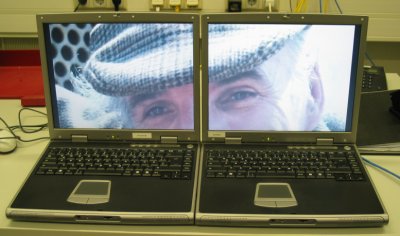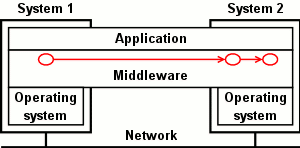Awesome multimedia technology heads for KDE
Apr 27, 2006 — by LinuxDevices Staff — from the LinuxDevices Archive — 3 views Phonon, an advanced multimedia architecture due in KDE 4.0, will be demonstrated at LinuxTag, May 3-6, in Wiesbaden, Germany. The Phonon architecture supports NMM (network-integrated multimedia middleware), enabling such capabilities as delivering synchronized audio and video presentations across… networked systems, controlled by a single, central application.
Phonon, an advanced multimedia architecture due in KDE 4.0, will be demonstrated at LinuxTag, May 3-6, in Wiesbaden, Germany. The Phonon architecture supports NMM (network-integrated multimedia middleware), enabling such capabilities as delivering synchronized audio and video presentations across… networked systems, controlled by a single, central application.
Phonon comprises a central hardware configuration database said to free multimedia applications from the need to configure hardware. This simplifies multimedia application development, according to the Phonon homepage. Additionally, Phonon will support NMM, an advanced multimedia middleware framework that, in itself, could bring a lot of new functionality to PCs and devices of all kinds.
NMM was developed at Saarland University in Saarbrucken, Germany, and was first demonstrated at CeBIT more than a year ago. Motama — a Saarland University spin-off that offers commercial licenses, support, and development services around the technology — was founded and is headed by Professor Philipp Slusallek, along with Dr. Marco Lohse and Michael Repplinger. NMM's license permits its use in commercial products, as well as open source and research projects.
What NMM can do
With NMM, multimedia content is readily shared among networked devices and even “handed over” from one device to another. One example is media playback, a task that can be handed over from a mobile MP3 player to a hi-fi system in a living room, for example, as a person approaches and then enters their home. As far as NMM is concerned, the devices on a network are all virtual devices, such that “a commodity mobile phone can become a radio receiver or the same video recording can be displayed on three TV sets simultaneously,” Lohse explained last year.
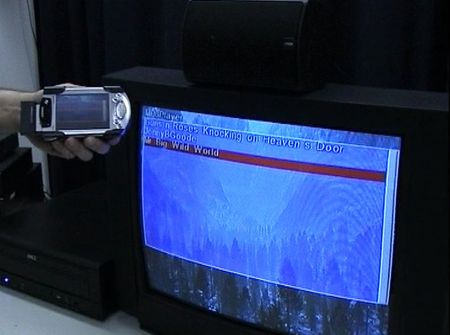
NMM “handing over” a song to a PDA
(Click to enlarge)
Other potential NMM applications include networked multimedia home entertainment systems, distributed and parallel media processing applications, distributed streaming servers and services, communication and control systems, large-scale multimedia installations such as video walls, and DRM (digital rights management), according to Motama.
NMM, shown distributing an image across two laptops — one running Linux, and the other running Windows
How NMM works
NMM supports a host of network transports and operating systems, and aims to make inter-system and inter-application media distribution transparent to developers, simplifying the creation of applications that, for example, distribute TV to multiple output devices. NMM works by moving multimedia applications away from their traditional client-server architecture, toward a more distributed middleware approach.
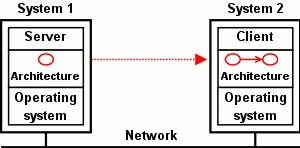
Traditional client-server (top) versus NMM multimedia architecture (bottom)
In the example of an application that distributes TV to multiple displays, the distributed architecture enables multiple systems to be transparently controlled from a single device. Or, output can be “handed off” from one display device to another. Yet another application might be performing resource-intensive transcoding on a PC, for display on a PDA.
What NMM includes
According to Motama, the NMM base architecture comprises:
- An “open micro-core” middleware architecture
- Uniform messaging system
- Extensible serialization and networking stack
- High level of abstraction using transparently distributed “flow graphs”
- Distributed synchronization architecture
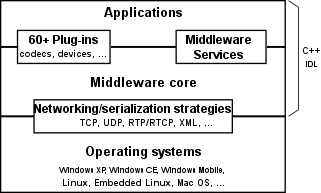
NMM middleware stack diagram
NMM's cross-platform core library currently runs on Linux, embedded Linux, and Mac OS X, as well as Windows XP, Windows CE, and Windows Mobile, according to Motama. It has an object-oriented C++ API and control interface, and boasts more than 60 plug-ins for I/O devices, codecs, data processing and on-screen display.
Services provided by NMM include a distributed peer-to-peer registry service that “administrates devices, software components, available processing power, and networking bandwidth;” a session-sharing service that allows participating hosts to share control, broker transcoding, and patch into running applications in order to share a single multimedia device; a seamless handover service, for example for “handing over media playback from a mobile system to a stationary device;” and an automatic application setup that launches computing resources as needed when a media source and output device are specified.
Availability
NMM is available now for download, either standalone or on a Knoppix-based live CD, from the NMM project homepage. More details about Motama's commercial NMM services can be found on its homepage, here. More about Phonon can be found at KDE.org, here.
This article was originally published on LinuxDevices.com and has been donated to the open source community by QuinStreet Inc. Please visit LinuxToday.com for up-to-date news and articles about Linux and open source.
